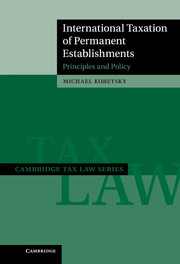Book contents
- Frontmatter
- Contents
- Abbreviations
- 1 Introduction
- 2 International taxation: policy and law
- 3 Some shortcomings of the tax treaty system
- 4 History of tax treaties and the permanent establishment concept
- 5 The role of the OECD Model Tax Treaty and Commentary
- 6 Defining the personality of permanent establishments under former Article 7 and the pre-2008 Commentary and the 2008 Commentary
- 7 Intra-bank loans under the pre-2008 Commentary and 1984 Report
- 8 Intra-bank interest under the 2008 Report
- 9 Business restructuring involving permanent establishments and the OECD transfer pricing methods
- 10 New Article 7 of the OECD Model and Commentary
- 11 Unitary taxation
- 12 Conclusion
- Bibliography
- Index
1 - Introduction
Published online by Cambridge University Press: 07 September 2011
- Frontmatter
- Contents
- Abbreviations
- 1 Introduction
- 2 International taxation: policy and law
- 3 Some shortcomings of the tax treaty system
- 4 History of tax treaties and the permanent establishment concept
- 5 The role of the OECD Model Tax Treaty and Commentary
- 6 Defining the personality of permanent establishments under former Article 7 and the pre-2008 Commentary and the 2008 Commentary
- 7 Intra-bank loans under the pre-2008 Commentary and 1984 Report
- 8 Intra-bank interest under the 2008 Report
- 9 Business restructuring involving permanent establishments and the OECD transfer pricing methods
- 10 New Article 7 of the OECD Model and Commentary
- 11 Unitary taxation
- 12 Conclusion
- Bibliography
- Index
Summary
Outline
The importance of bilateral tax treaties has increased significantly over the last sixty years with the extensive integration of national economies and the growth in the number of enterprises operating internationally. The growth in the tax treaty network has been phenomenal and there are presently over 3,000 tax treaties in force. The primary objective of tax treaties is to support international trade and investment by, inter alia, reducing the risk to business of double taxation, resulting from the overlapping of two countries' jurisdictions to tax. Tax treaties deal with the problem of overlapping tax jurisdictions by allocating taxing rights over items of income or taxpayers between the contracting countries. Tax treaties do not create jurisdiction to tax; rather, they allocate taxing rights between the treaty countries to prevent double taxation. International taxation comprises the interaction between the network of tax treaties and the domestic tax systems of countries. Most tax treaties are based on the Organisation for Economic Co-operation and Development (OECD) Model Tax Convention on Income and Capital (OECD Model) and it has become the keystone of the international tax treaty system. Moreover, the United Nations (UN) Model is based on the OECD Model.
A key feature of tax treaties is the allocation of business profits of international enterprises operating globally through permanent establishments under the business profits Article, Article 7 of the OECD Model. This provision became a broadly accepted treaty measure in the early part of the twentieth century when national economies were relatively independent and closed. Globalization has resulted in international enterprises and multinational enterprise groups operating across national borders as highly integrated businesses. International enterprises operate abroad through permanent establishments in host countries. On the other hand, multinational enterprise groups operate abroad through locally incorporated subsidiaries. International enterprises and multinational enterprise groups may use complex financial techniques and sophisticated tax planning arrangements to exploit the deficiencies in the tax treaty system. Former Article 7 has come under increasing pressure through globalization and there was no consensus interpretation of former Article 7 prior to the publication of the Report on the Attribution of Profits to Permanent Establishments (2008 Report) and the adoption by the OECD of the 2008 OECD Model, which incorporated some of the measures from the 2008 Report in the Commentary on former Article 7. A new Article 7 was adopted by the OECD in the 2010 OECD Model which fully implements the principles in the 2008 Report. At the same time, the OECD adopted the 2010 Report which is a revised version of the 2008 Report; the conclusions of the 2010 Report were amended to reflect the drafting and structure of new Article 7. Since 2001, the European Commission has been studying the implementation of formulary apportionment for EU enterprises. The OECD Article 7 reforms and the EU's formulary apportionment proposals are essentially a debate over the relative merits of the arm's length principle as compared with unitary formulary apportionment for allocating the profits of enterprises which operate in more than one country.
- Type
- Chapter
- Information
- International Taxation of Permanent EstablishmentsPrinciples and Policy, pp. 1 - 10Publisher: Cambridge University PressPrint publication year: 2011

